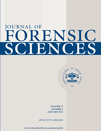Primary and Secondary Skeletal Blast Trauma* ,†
Presented at the 62nd Annual Meeting of the American Academy of Forensic Sciences, February 22–27, 2010, in Seattle, WA.
Funding for the study provided by the Terrorist Explosive Device Analytical Center (TEDAC).
Abstract
Abstract: This study examines primary (resulting from blast wave) and secondary (resulting from disintegrated, penetrating fragments) blast trauma to the skeleton. Eleven pigs were exposed to semi-controlled blast events of varying explosive type, charge size, and distance, including some cases with shrapnel. Skeletal trauma was found to be extensive, presenting as complex, comminuted fractures with numerous small, displaced bone splinters and fragments. Traumatic amputation of the limbs and cranium was also observed. Fractures were concentrated in areas nearer the blast, but there was generally no identifiable point of impact. Fractures were more random in appearance and widespread than those typically associated with gunshot or blunt force injury events. These patterns appear to be uniquely associated with blast trauma and may therefore assist forensic anthropologists and other forensic examiners in the interpretation of skeletal trauma by enabling them to differentiate between blast trauma and trauma resulting from some other cause.




